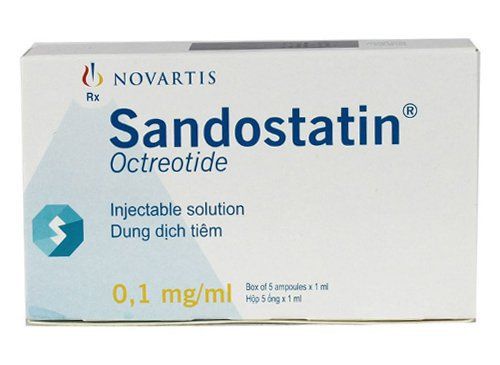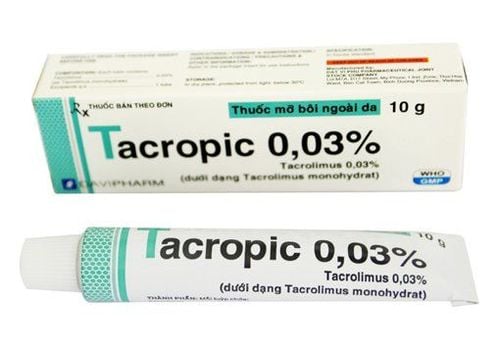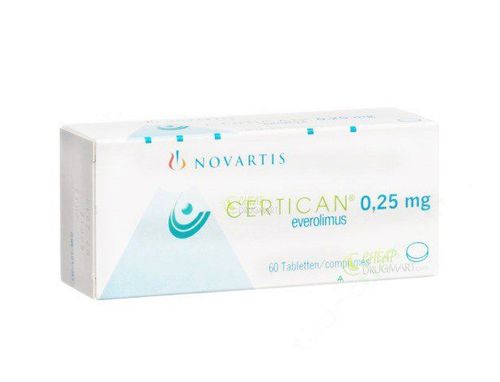This is an automatically translated article.
Currently on the market there are many articles related to the Tacrocap 0.5 drug line, but it is still not detailed. The following article would like to provide readers with information about the uses, usage and notes when using Tacrocap 0.5 for treatment.
1. What is Tacrocap 0.5?
Tacrocap 0.5 belongs to the group of anti-cancer drugs and affects the immune system, made in the form of soft capsules packed in a box of 1 blister, 2 blisters, 3 blisters, 4 blisters x 15 tablets.Tacrocap 0.5 drug has the main ingredient Tacrolimus (in the form of Tacrolimus monohydrate) 0.5mg and other excipients contained in the drug.
2. What are the effects of Tacrocap 0.5?
Tacrocap 0.5 is indicated for use in the following cases:
Prevention of transplant rejection in liver, kidney or heart transplant recipients. Transplant therapy in transplant recipients resistant to other immunosuppressive agents.
3. Dosage - How to take Tacrocap 0.5
3.1. How to use Tacrocap should be taken on an empty stomach or at least 1 hour before or 2-3 hours after a meal for maximum absorption of Tacrocap.
3.2. Dosage Dosage Tacrocap 0.5 for adults:
Patients receiving liver transplant: start taking 100-200 mcg Tacrolimus / kg per day, divided into 2 times. Heart transplant recipients: Initially 75 mcg Tacrolimus/kg daily, divided into 2 times. Renal transplant recipients: 150-300 mcg Tacrolimus/kg per day, in 2 divided doses. Dosage of Tacrocap 0.5 for children:
Children receiving liver and kidney transplants: initially take 300 mcg of Tacrolimus/kg per day, divided into 2 times.
Take Tacrocap right away about 6 hours after completing liver and heart transplant and within 24 hours after completing kidney transplant. The maintenance dose of Tacrocap should be adjusted according to the individual patient's tacrolimus whole blood or plasma trough concentrations. Most patients respond well when whole blood levels are maintained below 20 ng/ml. Children usually need a dose of Tacrocap 1.5 - 2 times the adult dose to achieve the same drug concentration in the blood.
3.3. What to do in case of an overdose of Tacrocap? There are no adequate data on overdose with Tacrocap. Symptoms of Tacrocap overdose include: Headache, tremor, nausea/vomiting, infection, urticaria, lethargy, increased serum creatinine concentration, increased blood urea nitrogen, increased alanine aminotransferase concentration.
Currently, there is no specific antidote for Tacrocap overdose. If an overdose of Tacrocap occurs, treatment should be symptomatic and supportive as necessary.
4. Contraindications to the use of Tacrocap
Tacrocap should not be used in cases of hypersensitivity to tacrolimus, other macrolides or any other ingredient in the formulation.5. Tacrocap drug interactions
Nephrotoxicity is increased when Tacrocap is used together with potentially nephrotoxic drugs such as ciclosporin, so the combination of these two drugs should be avoided.
Do not combine potassium-sparing diuretics with tacrolimus.
Tacrolimus active ingredient in the drug is metabolised via cytochrome P450 isoenzyme CYP3A4. These enzyme inhibitors such as azole antifungals, bromocriptine, cimetidine, calcium channel blockers, certain corticosteroids, ciclosporin, delavirdin, danazol, HIV-protease inhibitors, macrolide antibiotics and metoclopramide may increase plasma levels. tacrolimus in the blood.
Avoid grapefruit juice when taking Tacrocap because grapefruit juice can inhibit the metabolism of tacrolimus.
Drugs that induce cytochrome P450 isoenzyme CYP3A4 such as carbamazepine, nevirapine, phenytoin, phenobarbital and rifampicin may decrease tacrolimus blood levels. Live vaccines should be avoided during immunosuppressive Tacrocap therapy because of the increased risk of infection.
6. Side effects when taking Tacrocap
During the use of Tacrocap, patients may experience some unwanted side effects such as:
Common: tremor, headache, paresthesia, nausea and diarrhea, increased blood pressure, increased white blood cell count, leukopenia, renal failure, anemia, thrombocytopenia, electrolyte disturbances, hyperkalemia. Uncommon: Mood swings, confusion, sleep disturbances, dizziness, convulsions, tinnitus, visual disturbances, carbohydrate metabolism disorders, diabetes, constipation, dyspepsia, gastrointestinal bleeding, ECG changes and heart palpitations, myocardial hypertrophy, asthma, dyspnea, pleural effusion, alopecia, rash and pruritus, hirsutism, arthralgia or myalgia, coagulopathy, cramps, edema peripheral, liver dysfunction. Inform the treating doctor/pharmacist if you experience any unwanted effects when using Tacrocap.
7. Precautions when using Tacrocap
Avoid use of tacrolimus in patients with hypersensitivity to macrolides. Dosage adjustment may be necessary in patients with hepatic impairment and in patients with pre-existing renal impairment. Monitor blood levels of tacrolimus in all patients.
During the initial period after transplantation, the following parameters must be monitored: blood pressure, ECG, blood glucose, neurological and visual status, electrolytes (especially potassium), blood count, Coagulation index and plasma protein, liver and kidney function tests. If the patient's condition changes clinically, adjustment of immunosuppressive therapy should be considered.
Patients when taking Tacrocap drug increases the risk of infection and malignancy. Live vaccines or intrauterine devices should be used with caution during immunosuppressive Tacrocap therapy because of the increased risk of infection.
Tacrocap may affect nerve function and vision. Patients should avoid driving or operating machinery, doing dangerous jobs to avoid being affected by the unwanted effects of Tacrocap.
There have been reports of Tacrolimus crossing the placenta, however, the effect of Tacrolimus on the fetus is not known. There have been reports of maternal use of tacrolimus, occurrence of hyperkalemia and renal damage in the neonate. Therefore, it is necessary to be very careful when using Tacrocap for pregnant women, only using Tacrocap when absolutely necessary.
There are data showing that Tacrolimus is secreted into breast milk. Therefore, the mother should stop breastfeeding while taking Tacrocap.
Please dial HOTLINE for more information or register for an appointment HERE. Download MyVinmec app to make appointments faster and to manage your bookings easily.













